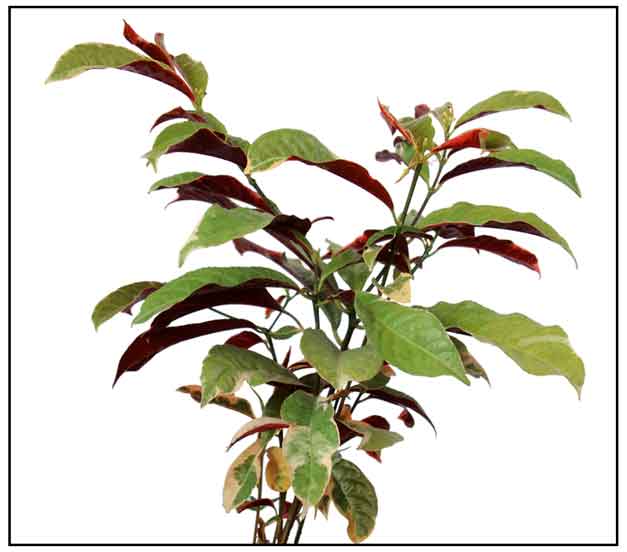
Gen info
"- The common name "blindness tree" derives from Lain "excoecaria" meaning "to make blind+ as the sap on the eye is reported to cause blindness.
= The species name cochinchinensis derives from Cochinchina, an old name for Vietnam. (11)
Botany
Excoecaria cochinchinensis is a shrub that grows to a height of 2 meters. Leaves are alternate, oblong, acuminate, up to 15 centimeters long and 5 centimeters wide, bright green above and crimson red below. Flowers are small and greenish.
Distribution
- Recently introduced to the Philippines.
- Garden cultivation; easy indoor growth.
- Native to China and Japan.
 Constituents Constituents
• Study of stems and roots of Excoecaria cochinchinensis var. viridis yielded 8 compounds: shikimic acid, 1-cyclohexane-1-carboxylic acid-5-hydroxy-3,4-isopropylidene-dioxy, oxy-bis(5-methylene-2-furaldehyde), beta-sitosterol, tetracosanoic acid, stearic acid and hentriacontane. (2)
• Study of extract of leaves and twigs isolated three new highly oxygenated diterpenoids. (1)
• Study of leaves yielded two compounds: gallic acid and ellagic acid. An ethyl acetate extract of leaves yielded two flavonols: kaempferol 7-0-glycoside and kaempferol. (9)
• Study of leaves isolated two new megastigmane glucosides, excoecariosides A and B,, from Excoecaria cochinchinensis Lour. var. cochinchinensis, together with seven known compounds. (4)
Properties
• Toxicity: Like many Euphorbiaceae species, the sap is toxic and can cause eczema in some, While toxic when eaten, it has been reportedly used in small amounts for the treatment of gastric ulcers; also used as haemostatic, antipruritic, and antiparasitic. (11)
•
Considered anti-parasitic, antipruritic, haemostatic, antimicrobial, uteretonic.
• Studies have suggested
anticancer, antimicrobial, anti-acne, uterotonic, aldose reductase inhibitory, anti-inflammatory, haemostatic properties.
Uses
Folkloric
• No known folkloric medicinal use in the Philippines.
• In Indonesia, decoction of leaves used for dysentery. Juice squeezed out of boiled leaves used for hematemesis. Roots used for post-partum hemorrhage. Decoction of roots considered abortifacient, and use not recommended during pregnancy. In India, decoction of leaves used for epilepsy. (6)
• Used in folk medicine for itching, furuncles, and allergies.
Studies
• Cytotoxicity / Anti-Cancer:
In a study of 120 plant extracts from 29 Indonesian plants tested in vitro cytotoxicity in cultured human lung, colon and stomach cancer cells, five extracts derived from E alba and Excoecaria cochinchinensis displayed potent cell-line selective cytotoxicity. (5)
• Chemical Constituents:
Study of stems and roots yielded 8 compounds: shikimic acid, 1-cyclohexane-1-carboxylic acid-5-hydroxy-3,4-isopropylidene-dioxy, oxy-bis(5-methylene-2-furaldehyde), beta-sitosterol, tetracosanoic acid, stearic acid and hentriacontane. (2)
• Antimicrobial / Anti-Acne:
Study showed the ethanolic and water extracts of E cochinchinensis to be effective against S aureus and Propionibacterium acnes. The water extract also showed outstanding activity against clindamycin resistant S aureus. Phytochemical analysis showed tannin and phenolic compounds. The study was looking for data for the development of anti-acne products from natural plant extracts. (3)
• Megastigmane Glucosides / Excoecariosides:
Study isolated two new megastigmane glucosides – excoecariosides A and B – from the leaves together with seven known compounds. (4)
• Aldose Reductase Inhibitory Activity:
Aldose reductase (AR) is a key enzyme in the polyol pathway, playing an important role in the pathogenesis of diabetic complications such as cataract formation. In a study of 49 Vietnam herbal medicines, Excoecaria cochinchinensis (aerial parts) is one of seven plants that exhibited significant inhibitory activity against aldose reductase. (7)
• Uterotonic Activity / Daphnane and Tigliane Factors / Leaves: Latex of Excoecaria bicolor yielded four fractions highly enriched in diterpene esters., acetone extract and EA fraction yielded daphnane and tigliane (diterpene esters). Daphnane type esters are currently in routine use in China for fertility regulation. Daphnane and tigiiane type Excoecaria factors present in the latex of E. bicolor may be responsible for the uterotonic activity of leaves used in Thai herbal medicine. (8)
• Aldose Reductase Inhibition / Aerial Parts: Aldose reductase is a key enzyme in the polyol pathway involved in the pathologic pathway of cataract formation. In a study of 49 Vietnam herbal medicines for in vitro aldose reductase inhibitory activities, 7 herbal medicines, including E. cochinchinensis aerial parts exhibited significant inhibitory activity against aldose reductase. (10)
• Anti-Inflammatory: Study in mice evaluated the anti-inflammatory effects of water and exthanol extracts from Exoecaria cochinchinensis using acute and chronic inflammation models of mouse paw edema induced by cotton ball granuloma and carrageenan, respectively. Both extracts exhibited significant anti-inflammatory effects. (12)
• Haemostasis Effect on Skin Wound / Leaves: Study evaluated the effect of haemostasis after applied Sambang Darah leaves in white rat skins (Rattus norvegicus). Results suggest sambang darah leaves can be applied as medicine for external wounds but cannot be applied in koagulasi test. (13)
Availability
Wild-crafted. |

![]()

